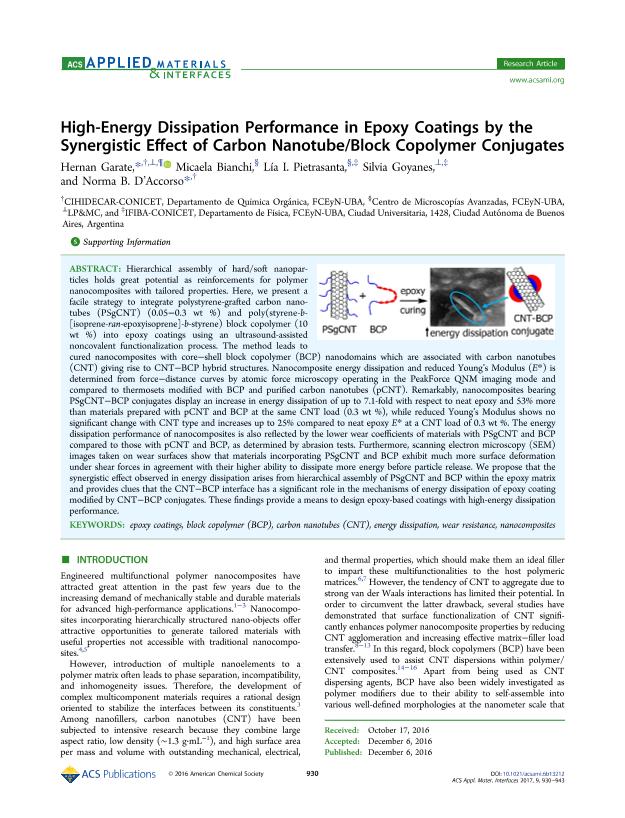Artículo
High-Energy Dissipation Performance in Epoxy Coatings by the Synergistic Effec of Carbon Nanotube/Block Copolymer Conjugate
Garate, Hernán ; Bianchi, Micaela
; Bianchi, Micaela ; Pietrasanta, Lia
; Pietrasanta, Lia ; Goyanes, Silvia Nair
; Goyanes, Silvia Nair ; D`accorso, Norma Beatriz
; D`accorso, Norma Beatriz
 ; Bianchi, Micaela
; Bianchi, Micaela ; Pietrasanta, Lia
; Pietrasanta, Lia ; Goyanes, Silvia Nair
; Goyanes, Silvia Nair ; D`accorso, Norma Beatriz
; D`accorso, Norma Beatriz
Fecha de publicación:
01/2017
Editorial:
American Chemical Society
Revista:
ACS Applied Materials & Interfaces
ISSN:
1944-8244
Idioma:
Inglés
Tipo de recurso:
Artículo publicado
Clasificación temática:
Resumen
Hierarchical assembly of hard/soft nanoparticles holds great potential as reinforcements for polymer nanocomposites with tailored properties. Here, we present a facile strategy to integrate polystyrene-grafted carbon nanotubes (PSgCNT) (0.05-0.3 wt %) and poly(styrene-b- [isoprene-ran-epoxyisoprene]-b-styrene) block copolymer (10 wt %) into epoxy coatings using an ultrasound-assisted noncovalent functionalization process. The method leads to cured nanocomposites with core-shell block copolymer (BCP) nanodomains which are associated with carbon nanotubes (CNT) giving rise to CNT-BCP hybrid structures. Nanocomposite energy dissipation and reduced Young's Modulus (E∗) is determined from force-distance curves by atomic force microscopy operating in the PeakForce QNM imaging mode and compared to thermosets modified with BCP and purified carbon nanotubes (pCNT). Remarkably, nanocomposites bearing PSgCNT-BCP conjugates display an increase in energy dissipation of up to 7.1-fold with respect to neat epoxy and 53% more than materials prepared with pCNT and BCP at the same CNT load (0.3 wt %), while reduced Young's Modulus shows no significant change with CNT type and increases up to 25% compared to neat epoxy E∗ at a CNT load of 0.3 wt %. The energy dissipation performance of nanocomposites is also reflected by the lower wear coefficients of materials with PSgCNT and BCP compared to those with pCNT and BCP, as determined by abrasion tests. Furthermore, scanning electron microscopy (SEM) images taken on wear surfaces show that materials incorporating PSgCNT and BCP exhibit much more surface deformation under shear forces in agreement with their higher ability to dissipate more energy before particle release. We propose that the synergistic effect observed in energy dissipation arises from hierarchical assembly of PSgCNT and BCP within the epoxy matrix and provides clues that the CNT-BCP interface has a significant role in the mechanisms of energy dissipation of epoxy coating modified by CNT-BCP conjugates. These findings provide a means to design epoxy-based coatings with high-energy dissipation performance.
Archivos asociados
Licencia
Identificadores
Colecciones
Articulos(CCT - PATAGONIA NORTE)
Articulos de CTRO.CIENTIFICO TECNOL.CONICET - PATAGONIA NORTE
Articulos de CTRO.CIENTIFICO TECNOL.CONICET - PATAGONIA NORTE
Articulos(CIHIDECAR)
Articulos de CENTRO DE INVESTIGACIONES EN HIDRATOS DE CARBONO
Articulos de CENTRO DE INVESTIGACIONES EN HIDRATOS DE CARBONO
Articulos(IFIBA)
Articulos de INST.DE FISICA DE BUENOS AIRES
Articulos de INST.DE FISICA DE BUENOS AIRES
Citación
Garate, Hernán; Bianchi, Micaela; Pietrasanta, Lia; Goyanes, Silvia Nair; D`accorso, Norma Beatriz; High-Energy Dissipation Performance in Epoxy Coatings by the Synergistic Effec of Carbon Nanotube/Block Copolymer Conjugate; American Chemical Society; ACS Applied Materials & Interfaces; 9; 1; 1-2017; 930-943
Compartir
Altmétricas



